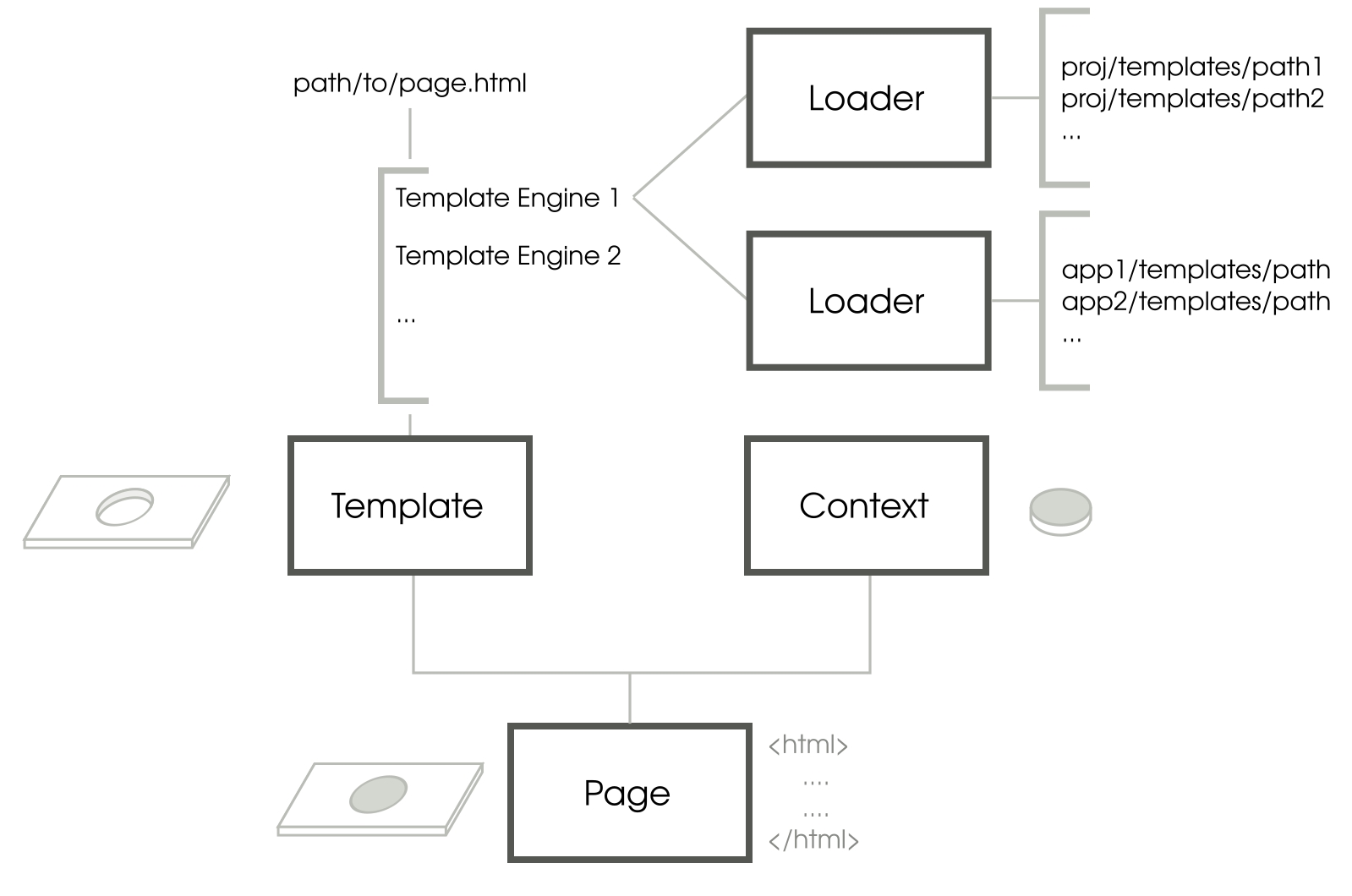Django renders templates while being agnostic of the actual template engine, as the following diagram shows:

Each template is rendered by trying each template backend specified by the TEMPLATES variable in settings.py in order.
A Loader object corresponding to the backend will search for the template. Based on the backend's configuration, several kinds of loaders will be used. For instance, filesystem.Loader loads templates from the filesystem according to DIRS, and app_directories.Loader loads templates from within app directories.
If a Loader is successful, the search ends and that particular backend template engine is chosen for rendering. This results in a Template object, which contains the parsed and compiled template.
To render a Template, you will need to provide it with a Context object. Context behaves exactly like a dictionary, but is implemented as a stack of dictionaries. If a Template is a container for placeholders, then Context provides the values that fill these placeholders.
While using Django Templates, you might be more familiar with RequestContext, which is a subclass of Context. A RequestContext adds more context to a template by running template context processors on the request. Jinja2 would not require context processors as it supports calling functions directly.
Finally, the render method of a Template object receives the context and renders the output. This might be an HTML, XML, email, CSS, or any textual output.
If you understand the template search order, then you can use it to your advantage to override the loaded templates. The following are some scenarios where this can comein handy:
- Override a third-party apps's template with your own project-defined template
- Use Jinja2 for performance-specific parts of your site and DTL for the rest
The first one is a common use case due to the popularity of CSS frameworks such as Bootstrap.
For the first time in weeks, Steve's office corner was bustling with frenetic activity. With more recruits, the now five-member team comprised of Brad, Evan, Jacob, Sue, and Steve. Like a superhero team, their abilities were deep and amazingly well-balanced.
Brad and Evan were the coding gurus. While Evan was obsessed over details, Brad was the big-picture guy. Jacob's talent in finding corner cases made him perfect for testing. Sue was in charge of marketing and design.
In fact, the entire design was supposed to be done by an avant-garde design agency. It took them a month to produce an abstract, vivid, color-splashed concept loved by the management. It took them another two weeks to produce an HTML-ready version from their Photoshop mockups. However, it was eventually discarded as it proved to be sluggish and awkward on mobile devices.
Disappointed by the failure of what was now widely dubbed as the unicorn vomit design, Steve felt stuck. Hart had phoned him quite concerned about the lack of any visible progress to show management.
In a grim tone, he reminded Steve, "We have already eaten up the project's buffer time. We cannot afford any last-minute surprises".
It was then that Sue, who had been unusually quiet since she joined, mentioned that she had been working on a mockup using Twitter's Bootstrap. Sue was the growth hacker in the team — a keen coder and a creative marketer.
She admitted having just rudimentary HTML skills. However, her mockup was surprisingly thorough and looked familiar to users of other contemporary social networks. Most importantly, it was responsive and worked perfectly on every device from tablets to mobiles.
The management unanimously agreed on Sue's design, except for someone named Madame O. One Friday afternoon, she stormed into Sue's cabin and began questioning everything from the background color to the size of the mouse cursor. Sue tried to explain to her with surprising poise and calm.
An hour later, when Steve decided to intervene, Madame O was questioning why the profile pictures had to be in a circle rather than a square. "But a site-wide change like that will never get over in time," he said. Madame O shifted her gaze to him and gave him a sly smile. Suddenly, Steve felt a wave of happiness and hope surged within him. It felt immensely relieving and stimulating. He heard himself happily agreeing to all she wanted.
Later, Steve learnt that Madame Optimism was a minor mentalist who could influence prone minds. His team loved to bring up the latter fact on the slightest occasion.
